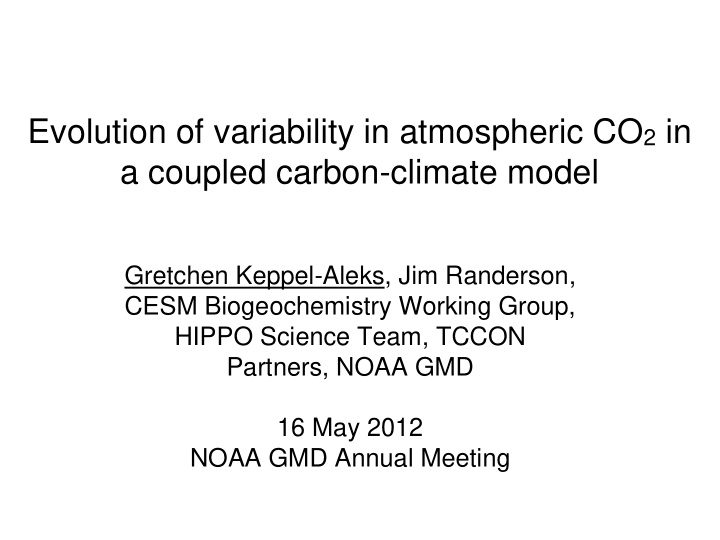



Evolution of variability in atmospheric CO 2 in a coupled carbon-climate model Gretchen Keppel-Aleks, Jim Randerson, CESM Biogeochemistry Working Group, HIPPO Science Team, TCCON Partners, NOAA GMD 16 May 2012 NOAA GMD Annual Meeting
Project Goals Evaluate CO 2 fields in CESM against observations to determine how accurately CESM captures seasonal, interannual, and decadal variations in CO 2 Link changes in 21st century CO 2 to fluxes and climate drivers Determine how the changes in atmospheric CO 2 might impact our ability to use monitoring networks for flux attribution
Atmospheric CO 2 Observations Scripps MLO We use multiple observational platforms to evaluate 3-D CO 2 fields in CESM.
Growth rate in atmospheric CO 2 CESM airborne fraction of anthropogenic CO 2 is 25% higher than observations.
Interhemispheric CO 2 difference CESM has higher northern hemisphere background CO 2 , opposite what is inferred Intercept: -1.5 ppm from the observations, likely due to weak exchange in Southern Ocean. Intercept: +1.0 ppm
Seasonal patterns in surface CO 2 GMD CESM Seasonal and spatial patterns in CO 2 are underestimated in CESM.
Phasing of the seasonal cycle in surface CO 2 The onset of the growing season occurs too early in CESM. Barrow: 71 ° N , 151 ° W Maximum solid: GMD [ppm] CO 2 dash: CESM Zero 1 Zero 2 Minimum
Seasonal variations in column CO 2 Total column CO 2 suggests that CESM northern hemisphere NEP is small during the growing season by 50%.
CO 2 gradients in the free troposphere HIPPO data show larger north-south gradients during the growing season and more vertical stratification than CESM.
Vertical propagation of the seasonal cycle solid: GMD dash: CESM Ratio of seasonal cycle amplitude at altitude to seasonal cycle amplitude at 3.5 km Seasonal cycle amplitudes are similar at the surface and aloft in CESM, whereas observations show a larger decrease in amplitude with altitude.
Mean vertical profiles in midlatitudes (40- 60N) solid: GMD dash: CESM Seasonal cycle amplitudes are similar at the surface and aloft in CESM, whereas observations show a larger decrease in amplitude with altitude.
CESM: trends in East-West surface gradient Trends in CO 2 relative to SPO [ppm yr -1 ] Site Data CESM CESM(FFF) Tae-Ahn 0.17 0.19 0.19 Mace Head 0.06 0.02 0.07 Mauna Loa 0.06 0.02 0.06 Samoa 0.03 -0.04 0.01 Tae-Ahn site on Korean peninsula shows larger growth rate than do sites in remote locations.
CMIP5 Representative Concentration Pathways Divergent fossil fuel emissions trajectories in RCP 4.5 and RCP 8.5 scenarios leads to large differences in atmospheric CO 2 and surface temperature in the Community Earth System Model (CESM).
Conclusions and future work Northern hemisphere growing season net flux underestimated in CESM Weak Southern Ocean storage of CO 2 affects growth rate and gradients Atmospheric vertical mixing too diffusive during the summer leading to weak vertical stratification. Large differences emerge in the 21st century as fossil fuel emissions follow different trajectories -- offline discussion
North-south gradient in surface CO 2 The northern hemisphere growing season north-south gradient is underestimated in CESM.
Recommend
More recommend